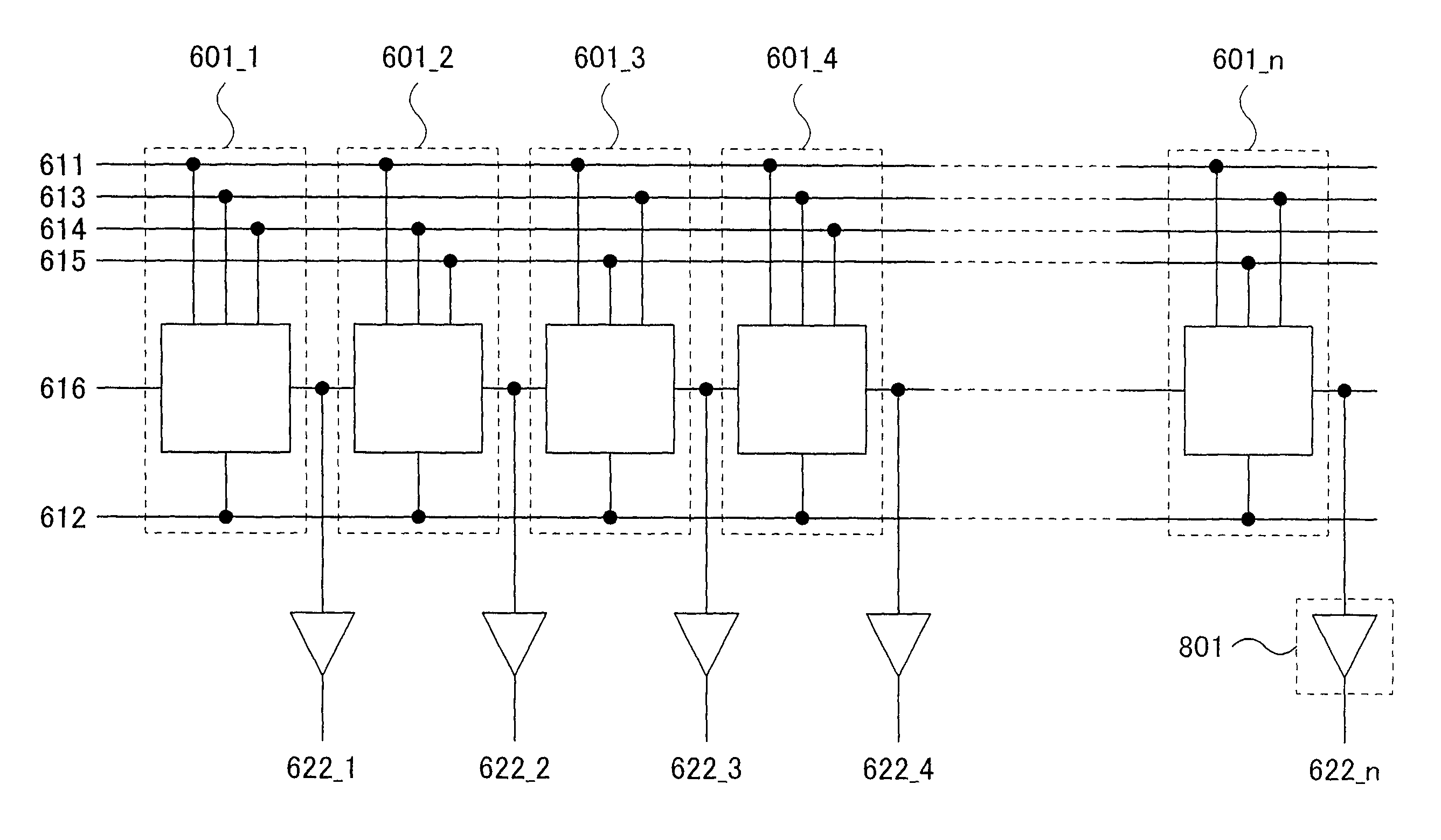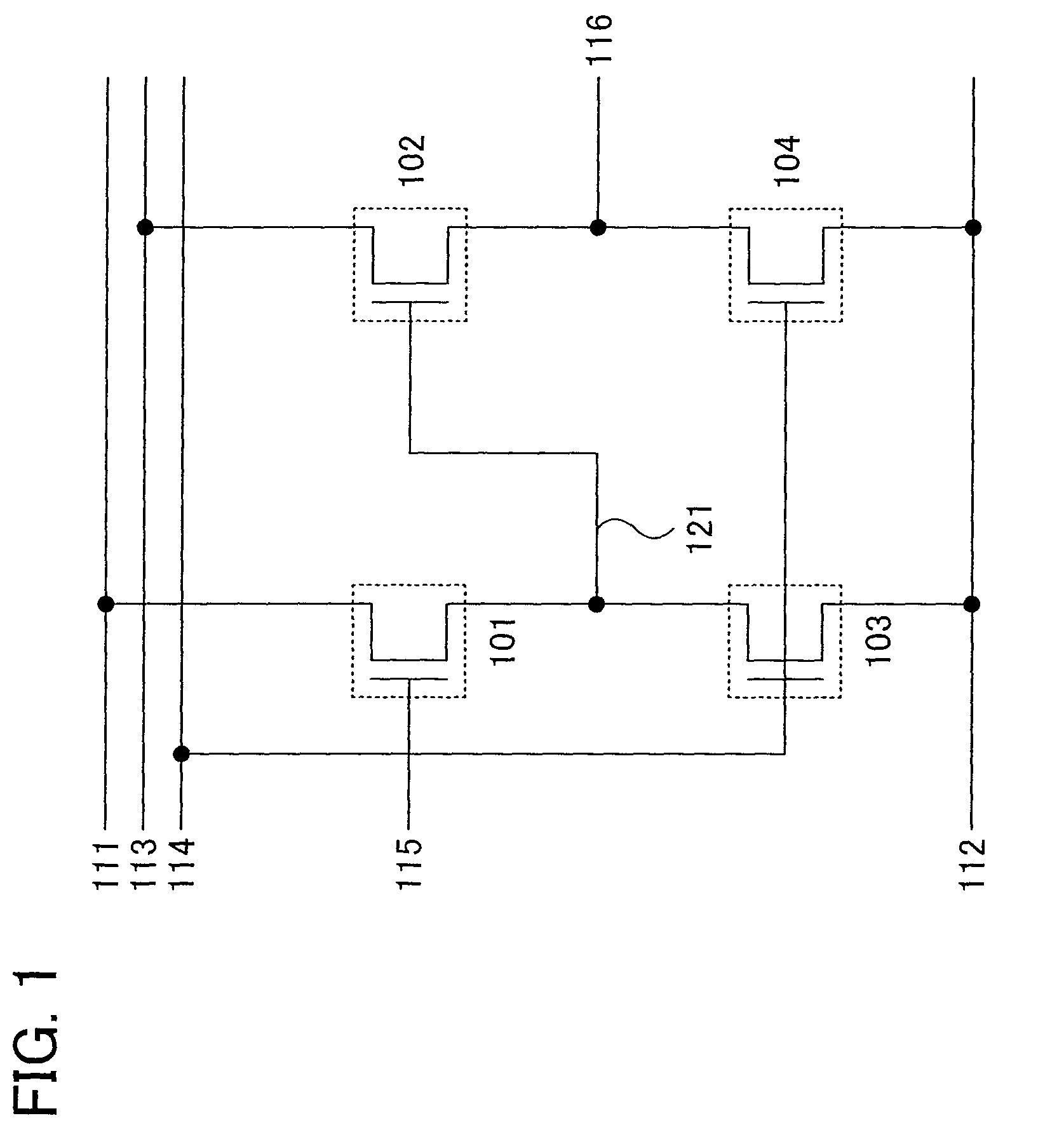Liquid crystal display device
a liquid crystal display device and display defect technology, applied in static indicating devices, instruments, optics, etc., can solve problems such as the deterioration of the characteristics of transistors formed of non-crystalline semiconductors, and achieve the suppression of the display defect of liquid crystal display devices caused by a shift register malfunction
- Summary
- Abstract
- Description
- Claims
- Application Information
AI Technical Summary
Benefits of technology
Problems solved by technology
Method used
Image
Examples
embodiment mode 1
[0188]In this embodiment mode, a basic structure of a shift register of a display device of the present invention is described with reference to drawings. FIG. 1 shows a flip-flop of one stage (e.g., a first stage), which is one of a plurality of flip-flops included in a shift register. The flip-flop shown in FIG. 1 includes a first transistor 101, a second transistor 102, a third transistor 103, and a fourth transistor 104. Note that the flip-flop is connected to a first wiring 111, a second wiring 112, a third wiring 113, a fourth wiring 114, a fifth wiring 115, and a sixth wiring 116. In this embodiment mode, each of the first transistor 101, the second transistor 102, the third transistor 103, and the fourth transistor 104 is an N-channel transistor and is turned on when gate-source voltage (Vgs) exceeds the threshold voltage (Vth). Note that the first wiring 111 and the second wiring 112 may be called a first power supply line and a second power supply line, respectively. In ad...
embodiment mode 2
[0256]In this embodiment mode, a flip-flop having a structure which is different from that of Embodiment Mode 1 is shown in FIG. 13. Note that portions which are similar to Embodiment Mode 1 are denoted by common reference numerals and detailed description of the portions which are the same and portions which have similar functions is omitted.
[0257]The flip-flop shown in FIG. 13 includes the first transistor 101, the second transistor 102, the third transistor 103, the fourth transistor 104, and a fifth transistor 1305. Note that the flip-flop is connected to the first wiring 111, the second wiring 112, the third wiring 113, the fourth wiring 114, the fifth wiring 115, the sixth wiring 116, and a seventh wiring 1317. In this embodiment mode, the fifth transistor 1305 is an N-channel transistor and is turned on when gate-source voltage (Vgs) exceeds the threshold voltage (Vth). Note that the seventh wiring 1317 may be called a third signal line.
[0258]The first terminal (one of the so...
embodiment mode 3
[0281]In this embodiment mode, a flip-flop having a structure which is different from those of Embodiment Modes 1 and 2 is shown in FIG. 19. Note that portions which are similar to Embodiment Modes 1 and 2 are denoted by common reference numerals and detailed description of the portions which are the same and portions which have similar functions is omitted.
[0282]The flip-flop shown in FIG. 19 includes the first transistor 101, the second transistor 102, the third transistor 103, the fourth transistor 104, the fifth transistor 1305, a sixth transistor 1906, a seventh transistor 1907, an eighth transistor 1908, and a ninth transistor 1909. Note that the flip-flop is connected to the first wiring 111, the second wiring 112, the third wiring 113, the fourth wiring 114, the fifth wiring 115, the sixth wiring 116, and the seventh wiring 1317. In this embodiment mode, each of the sixth transistor 1906, the seventh transistor 1907, the eighth transistor 1908, and the ninth transistor 1909 ...
PUM
 Login to View More
Login to View More Abstract
Description
Claims
Application Information
 Login to View More
Login to View More - R&D
- Intellectual Property
- Life Sciences
- Materials
- Tech Scout
- Unparalleled Data Quality
- Higher Quality Content
- 60% Fewer Hallucinations
Browse by: Latest US Patents, China's latest patents, Technical Efficacy Thesaurus, Application Domain, Technology Topic, Popular Technical Reports.
© 2025 PatSnap. All rights reserved.Legal|Privacy policy|Modern Slavery Act Transparency Statement|Sitemap|About US| Contact US: help@patsnap.com



